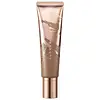What's inside
What's inside
 Key Ingredients
Key Ingredients

 Benefits
Benefits

 Concerns
Concerns

 Ingredients Side-by-side
Ingredients Side-by-side

Water
Skin ConditioningButyloctyl Salicylate
Skin ConditioningIsododecane
EmollientButylene Glycol Dicaprylate/Dicaprate
EmollientMica
Cosmetic ColorantHydrogenated Poly(C6-14 Olefin)
EmollientHydrogenated Polydecene
EmollientHydrogenated Polyisobutene
EmollientOrbignya Oleifera Seed Oil
EmollientPropanediol
SolventVinyl Dimethicone/Methicone Silsesquioxane Crosspolymer
Cetyl PEG/PPG-10/1 Dimethicone
EmulsifyingSynthetic Fluorphlogopite
Butylene Glycol
HumectantMagnesium Sulfate
Disteardimonium Hectorite
StabilisingHexyl Laurate
EmollientPolyglyceryl-4 Isostearate
EmulsifyingParfum
MaskingCaprylyl Glycol
EmollientTocopheryl Acetate
AntioxidantEthylhexylglycerin
Skin ConditioningLecithin
EmollientTriethoxycaprylylsilane
Propylene Carbonate
SolventSorbitan Isostearate
Emulsifying1,2-Hexanediol
Skin ConditioningDimethicone
EmollientQuercetin
AntioxidantDisodium EDTA
Tin Oxide
AbrasivePentaerythrityl Tetra-Di-T-Butyl Hydroxyhydrocinnamate
AntioxidantCI 77891
Cosmetic ColorantIron Oxides
Water, Butyloctyl Salicylate, Isododecane, Butylene Glycol Dicaprylate/Dicaprate, Mica, Hydrogenated Poly(C6-14 Olefin), Hydrogenated Polydecene, Hydrogenated Polyisobutene, Orbignya Oleifera Seed Oil, Propanediol, Vinyl Dimethicone/Methicone Silsesquioxane Crosspolymer, Cetyl PEG/PPG-10/1 Dimethicone, Synthetic Fluorphlogopite, Butylene Glycol, Magnesium Sulfate, Disteardimonium Hectorite, Hexyl Laurate, Polyglyceryl-4 Isostearate, Parfum, Caprylyl Glycol, Tocopheryl Acetate, Ethylhexylglycerin, Lecithin, Triethoxycaprylylsilane, Propylene Carbonate, Sorbitan Isostearate, 1,2-Hexanediol, Dimethicone, Quercetin, Disodium EDTA, Tin Oxide, Pentaerythrityl Tetra-Di-T-Butyl Hydroxyhydrocinnamate, CI 77891, Iron Oxides
Water
Skin ConditioningCaprylic/Capric Triglyceride
MaskingGlycerin
HumectantOctyldodecyl Stearoyl Stearate
EmollientGlyceryl Stearate Se
EmulsifyingPropanediol
SolventCoco-Caprylate/Caprate
EmollientCetyl Alcohol
EmollientMoringa Oleifera Seed Oil
EmollientSqualane
EmollientButyrospermum Parkii Butter
Skin ConditioningMica
Cosmetic ColorantPhenoxyethanol
PreservativeCaprylyl Glycol
EmollientTocopheryl Acetate
AntioxidantXanthan Gum
EmulsifyingTrisodium Ethylenediamine Disuccinate
Leontopodium Alpinum Flower/Leaf Extract
Skin ConditioningLauroyl Lysine
Skin ConditioningCitric Acid
BufferingTocopherol
AntioxidantCI 77891
Cosmetic ColorantCI 77492
Cosmetic ColorantCI 77499
Cosmetic ColorantCI 77491
Cosmetic ColorantWater, Caprylic/Capric Triglyceride, Glycerin, Octyldodecyl Stearoyl Stearate, Glyceryl Stearate Se, Propanediol, Coco-Caprylate/Caprate, Cetyl Alcohol, Moringa Oleifera Seed Oil, Squalane, Butyrospermum Parkii Butter, Mica, Phenoxyethanol, Caprylyl Glycol, Tocopheryl Acetate, Xanthan Gum, Trisodium Ethylenediamine Disuccinate, Leontopodium Alpinum Flower/Leaf Extract, Lauroyl Lysine, Citric Acid, Tocopherol, CI 77891, CI 77492, CI 77499, CI 77491
Ingredients Explained
These ingredients are found in both products.
Ingredients higher up in an ingredient list are typically present in a larger amount.
Caprylyl Glycol is a humectant and emollient, meaning it attracts and preserves moisture.
It is a common ingredient in many products, especially those designed to hydrate skin. The primary benefits are retaining moisture, skin softening, and promoting a healthy skin barrier.
Though Caprylyl Glycol is an alcohol derived from fatty acids, it is not the kind that can dry out skin.
This ingredient is also used as a preservative to extend the life of products. It has slight antimicrobial properties.
Learn more about Caprylyl GlycolCi 77891 is a white pigment from Titanium dioxide. It is naturally found in minerals such as rutile and ilmenite.
It's main function is to add a white color to cosmetics. It can also be mixed with other colors to create different shades.
Ci 77891 is commonly found in sunscreens due to its ability to block UV rays.
Learn more about CI 77891Mica is a naturally occurring mineral used to add shimmer and color in cosmetics. It can also help improve the texture of a product or give it an opaque, white/silver color.
Serecite is the name for very fine but ragged grains of mica.
This ingredient is often coated with metal oxides like titanium dioxide. Trace amounts of heavy metals may be found in mica, but these metals are not harmful in our personal products.
Mica has been used since prehistoric times throughout the world. Ancient Egyptian, Indian, Greek, Roman, Aztec, and Chinese civilizations have used mica.
Learn more about MicaPropanediol is an all-star ingredient. It softens, hydrates, and smooths the skin.
It’s often used to:
Propanediol is not likely to cause sensitivity and considered safe to use. It is derived from corn or petroleum with a clear color and no scent.
Learn more about PropanediolTocopheryl Acetate is AKA Vitamin E. It is an antioxidant and protects your skin from free radicals. Free radicals damage the skin by breaking down collagen.
One study found using Tocopheryl Acetate with Vitamin C decreased the number of sunburned cells.
Tocopheryl Acetate is commonly found in both skincare and dietary supplements.
Learn more about Tocopheryl AcetateWater. It's the most common cosmetic ingredient of all. You'll usually see it at the top of ingredient lists, meaning that it makes up the largest part of the product.
So why is it so popular? Water most often acts as a solvent - this means that it helps dissolve other ingredients into the formulation.
You'll also recognize water as that liquid we all need to stay alive. If you see this, drink a glass of water. Stay hydrated!
Learn more about Water